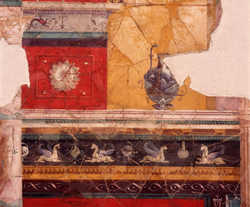La Casa di Augusto sul Palatino: il recupero e il restauro della decorazione pittoricaEstratto dal fasc. 2 - serie VII |
 Particolare dei motivi decorativi su una delle pareti |
|
|
Luciana Borrello: Storia degli scavi e degli studi Gianna Musatti: L’intervento di restauro e considerazioni sulla tecnica pittorica Dopo un contributo riguardante gli scavi condotti sin dal 1865 in varie riprese nella Casa di Augusto sul Palatino e una sintetica storia degli studi al riguardo, ampio spazio è dato alla presentazione degli interventi di restauro, condotti da personale della Soprintendenza per i Beni Archeologici di Roma a partire dagli anni Settanta e per circa un trentennio, essenzialmente con fondi di contabilità straordinaria, su gran parte della decorazione pittorica ivi ritrovata. Tali interventi si sono articolati sia nel recupero e nella rimessa in opera degli affreschi rinvenuti in frammenti soprattutto durante le campagne di scavo della seconda metà del secolo scorso, e a lungo conservati nei depositi insieme ai resti di stucchi che decoravano le volte di alcuni ambienti (anch’essi contestualmente fatti oggetto di restauro), sia nel restauro di quelli rimasti in situ. In questo caso sono stati consolidati gli intonaci dove mancavano di coesione o di adesione alla muratura originale, ed asportati i residui terrosi dello scavo dalla superficie pittorica, fissando leggermente il colore dove si presentava decoeso o sollevato in scaglie. Gli affreschi rinvenuti in frammenti hanno invece richiesto un complesso lavoro di ricomposizione condotto pazientemente per anni in laboratorio, fino all’adozione — nelle parti lacunose più piccole, preventivamente stuccate — della tecnica del “puntinato” (che segue i principi generali del “tratteggio”) per rendere più leggibili i dipinti. È poi seguita una ricerca specifica per la realizzazione dei supporti idonei a sostenere e conservare le pitture da ricollocarsi nel sito originario: ciò ha consentito il recupero quasi totale della decorazione di alcuni ambienti, a tutt’oggi divenuti visitabili dal pubblico. Nel corso di tutti gli interventi si sono potute fare molteplici osservazioni sui materiali e sulle tecniche esecutive degli affreschi, qui puntualmente riportate nel testo. The House of Augustus on the Palatine: the recovery and restoration of the pictorial decoration Luciana Borrello: History of the excavations and of studies Gianna Musatti: The restoration and remarks on the pictorial technique After a contribution dedicated to recounting the history of the excavations of the House of Augustus on the Palatine, conducted in a series of campaigns since 1865, and a historical résumé of studies on the site, a detailed account is dedicated to the restoration of a large part of the pictorial decoration found in the house. Conducted by the personnel of the Soprintendenza per i Beni Archeologici di Roma over a period of three decades since the 1970s, this ambitious restoration project was essentially conducted with funds drawn from the Soprintendenza’s ordinary budget. It has consisted not only of the restoration of the frescoes that have remained in situ, but also of the recovery and re-installation of the frescoes found in fragments; they were especially discovered during the excavation campaigns conducted in the second half of the last century, and were long consigned to the Soprintendenza’s storerooms together with the remains of the stuccoes that decorated the ceilings of some of the rooms (they too currently being restored). As far as the restoration of the frescoes that have remained in situ is concerned, the plaster supports were consolidated where lacking in cohesion or where they had become detached from the original structure of the wall. Residues of earth left by the excavations were also removed from the pictorial surfaces. Where the colour had lost its cohesion, or had flaked from the plaster, it was slightly re-stabilized with the use of a fixative. The frescoes found in fragments, on the other hand, required a complex work of re-composition conducted painstakingly in the laboratory over many years. In smaller gaps in the frescoes, where the pigment had been lost, the lacunae were first stuccoed and then the puntinato (dotted) technique was adopted (a technique that follows the general principle of hatching) to make the paintings more legible. Specific research was then conducted to identify and realize the most suitable supports to ensure the long-term conservation of the paintings thus reassembled, prior to their re-installation in their original site. This process of re-composition and re-installation permitted the almost total recovery of the decoration of some rooms, which have now become re-accessible to the public. During all these interventions, many observations could be made on the materials used in the frescoes and the techniques used in their execution. These are punctually reported in the text.
|
||







